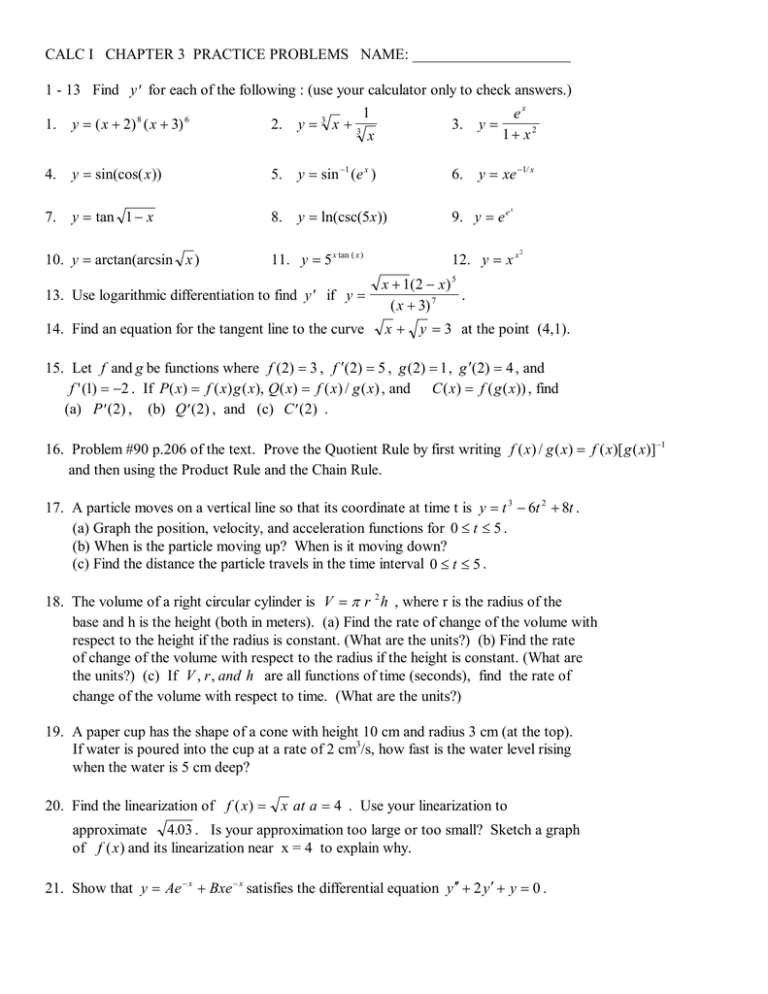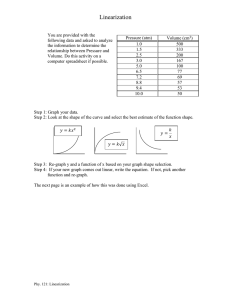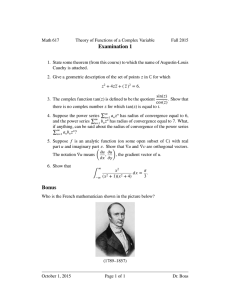CALC I CHAPTER 3 PRACTICE PROBLEMS ... ′ 1 - 13 Find
advertisement

CALC I CHAPTER 3 PRACTICE PROBLEMS NAME: _____________________ 1 - 13 Find y ′ for each of the following : (use your calculator only to check answers.) ex 1+ x2 1. y = ( x + 2) 8 ( x + 3) 6 2. y=3 x+ 1 3 x 3. y= 4. y = sin(cos( x )) 5. y = sin −1 (e x ) 6. y = xe −1/ x 7. y = tan 1 − x 8. y = ln(csc(5x )) 9. y = e e 10. y = arctan(arcsin x ) 11. y = 5 x tan ( x ) x 12. y = x x 2 13. Use logarithmic differentiation to find y ′ if y = x + 1( 2 − x ) 5 . ( x + 3) 7 14. Find an equation for the tangent line to the curve x + y = 3 at the point (4,1). 15. Let f and g be functions where f (2) = 3 , f ′(2) = 5 , g (2) = 1 , g ′(2) = 4 , and f ' (1) = −2 . If P( x) = f ( x) g ( x), Q( x) = f ( x) / g ( x) , and C ( x) = f ( g ( x)) , find (a) P ′(2) , (b) Q ′(2) , and (c) C ′(2) . 16. Problem #90 p.206 of the text. Prove the Quotient Rule by first writing f ( x) / g ( x) = f ( x)[ g ( x)]−1 and then using the Product Rule and the Chain Rule. 17. A particle moves on a vertical line so that its coordinate at time t is y = t 3 − 6t 2 + 8t . (a) Graph the position, velocity, and acceleration functions for 0 ≤ t ≤ 5 . (b) When is the particle moving up? When is it moving down? (c) Find the distance the particle travels in the time interval 0 ≤ t ≤ 5 . 18. The volume of a right circular cylinder is V = π r 2 h , where r is the radius of the base and h is the height (both in meters). (a) Find the rate of change of the volume with respect to the height if the radius is constant. (What are the units?) (b) Find the rate of change of the volume with respect to the radius if the height is constant. (What are the units?) (c) If V , r , and h are all functions of time (seconds), find the rate of change of the volume with respect to time. (What are the units?) 19. A paper cup has the shape of a cone with height 10 cm and radius 3 cm (at the top). If water is poured into the cup at a rate of 2 cm3/s, how fast is the water level rising when the water is 5 cm deep? 20. Find the linearization of f ( x ) = x at a = 4 . Use your linearization to approximate 4.03 . Is your approximation too large or too small? Sketch a graph of f ( x ) and its linearization near x = 4 to explain why. 21. Show that y = Ae − x + Bxe − x satisfies the differential equation y ′′ + 2 y ′ + y = 0 .











